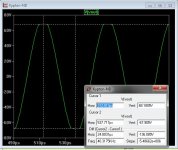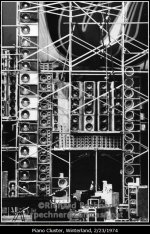Sure, but do the lifetime specifications by reputable manufacturers hold up here? I think we can all agree that derating is an objective practice, and that it can be calculated. So, if I've calculated the cap target lifetime based on working temperature and ripple current, and ensure that the rated voltage is not exceeded except within the surge tolerance allowed by the manufacturer, then what else is left to derate?
I think derating for voltage would even under those conditions be prudent, but of course it comes at a cost. I just never redline elco's and most certainly not tantalums.
My observation , is at those levels ... how you would not hear any
harmonics.
OS
So I guess, all low distortion amps sound the same, because " at those levels ... how you would not hear any harmonics. " ?
So I guess, all low distortion amps sound the same, because " at those levels ... how you would not hear any harmonics. " ?
Yes.
So I guess, all low distortion amps sound the same, because " at those levels ... how you would not hear any harmonics. " ?
You left out the other criteria for "sounding the same" - not clipping, low noise, flat frequency response.
Yes, and I think about in that order of importance, although SET-sorts-of-amps and other high-output-Z ones can push the departure from frequency response flatness to the forefront. Such colorations are the easiest things to hear. There is also crossover distortion at low levels that can be pretty arresting, but is so easy to avoid that it's rarely that evident.You left out the other criteria for "sounding the same" - not clipping, low noise, flat frequency response.
Keith Howard did his own and self-confessed non-DBT evaluation of the notion of euphonic nonlinear distortions a la Hiraga et al., concluding that for him at least cleaner was always better. When I read of the virtues of a specifically-shaped harmonic spectrum being superior to vanishingly low distortion, both cases well below clipping, it sounds like we are back to a sound generation/origination perspective---like the understandably-appreciated behavior of guitar amps---rather than sound reproduction. This led me once to quip to Olive that an audio product was very musical---it made everything sound like a cello.
Brad
Even so, this still begs the question: are you building whatever for the measurement gear or for your ears?
Or more to the point, your "soul."
se
You left out the other criteria for "sounding the same" - not clipping, low noise, flat frequency response.
At <1ppm - 5hz - 100Khz , > -115db noise , and all the other attributes
of a high bandwidth amp .... are usually part of the "package".
"Sounding the same" .... The CFA's and VFA's (power amps)
usually can be brought down
to the same 20ppm THD levels . But they do sound different.
Perhaps the feedback Z is a player here ?
I listened to almost a thousand tracks on the leach amp (with servo).
At 100 with my newly installed CFA module (with servo) ,
I have already altered the DSP to my liking (something is different).
But , they spec out the same ?
Clipping ? Nope ... I'd blow my speakers well before that could happen
And If it did (below).
"low noise" ? I'm trying to see (design/build), to see if I can beat
the noise limit of the BCxxx BJT's. Curl says the FET's can do this.
>-110db on any power amp can't be heard at 10CM from a
92db tweeter. Any improvement would be for "bragging rights".
For headphones - I'd like close to -120db.
Attachments
But they do sound different.
Is there any actual evidence for this or is it more anecdote based on uncontrolled experiments?
How low does thd or individual harmonic(s) have to be to think the amps are all the same?
Read Geddes and Lee.
How low does thd or individual harmonic(s) have to be to think the amps are all the same?
Curious as to the varied opinions here. Put a number on it.
THx-RNMarsh
5% (speaker distortion)
It's not the THD , it's the attributes of the particular design.
OS
Too many varied opinions, including the cynical ones. Higher order odds, i.e. 7,9,11 are the worst. Everything else is up for grabs. IF you have too much 2'nd harmonic, you will change the sound, but it still might sound OK. 3'rd harmonic can be more tolerated than many people expect. 5th harmonic is the turning point, less is best.
Is there any actual evidence for this or is it more anecdote based on uncontrolled experiments?
long term exposure to the same source/material while using the
exact same output stage/power supply (modular).
If I was to A/B a Parasound HCA2200 vs. a Pass Labs X250 , the
builds , (PS / layout/devices) would be very different.
With a modular , all remains the same .. (except the finer points of
the input stage topology). Not fully controlled , but closer than most.
I'm not a believer in boutique capacitors and silver/gold layouts , but
designs can "sound different".
PS - Objectively , some amps do have faster slew or have a different
DC feedback scheme (servo or cap). So , they have different spec's.
OS
IIRC John Curl posted a while back asking what we should be doing next. It seems that we are at something of an impasse, as linearizing loudspeakers cries out for incorporating them in the error correction process. And although this can be and has been done in various ways, including some very good powered loudspeakers (remember the Meridian ones some years back?), they don't flourish in the marketplace (speaking in a relative sense) because aficionados want to mix and match---it is part of the fun.5% (speaker distortion)
OS
I think manufacturers make marketing mistakes when bundling amplifiers and EQ with the loudspeaker---not because it doesn't work well, but because of the inflexibility. That amazingly flat M2 on-axis response comes at a price, and not meaning the 20k$: you must buy it with a little EQ, electronic crossovers, and amps. I'm told that for studio monitor use the amps are Crown and for home use, Mark Levinsons. I don't know which ML models.
It's probably a sign of burgeoning senility that I'm starting to worry about marketing.
Brad,
I am one on the other side of things, a speaker designer who would love to put the speaker into the feedback loop. I have been reading about current driven speakers rather than voltage driven and all the differences in implementation. It is not an easy thing to do correctly it appears. But to do that you do have to lock in the amplifier and crossover and such or it just doesn't work. So that mixing and matching paradigm has to go away for that to work. There is just a limit to what you can do with a dynamic driver in isolation to reduce distortion, the next step is to include the speaker in the feedback loop if we are truly after getting to the next level. Otherwise I would say we have reached the end of the road years ago and now it is all just marketing and nothing real is happening except on the digital side of the equation. Sh*t I can still design a great sounding set of speakers and use an old JBL D130 if the magnet is still charged and it will sound as good as most anything built in the last 30 years!
I am one on the other side of things, a speaker designer who would love to put the speaker into the feedback loop. I have been reading about current driven speakers rather than voltage driven and all the differences in implementation. It is not an easy thing to do correctly it appears. But to do that you do have to lock in the amplifier and crossover and such or it just doesn't work. So that mixing and matching paradigm has to go away for that to work. There is just a limit to what you can do with a dynamic driver in isolation to reduce distortion, the next step is to include the speaker in the feedback loop if we are truly after getting to the next level. Otherwise I would say we have reached the end of the road years ago and now it is all just marketing and nothing real is happening except on the digital side of the equation. Sh*t I can still design a great sounding set of speakers and use an old JBL D130 if the magnet is still charged and it will sound as good as most anything built in the last 30 years!
If all the amps sound the same, just a question for the pure objectivists.
Why bother to design, build or buy new amps, or spend time in forums like this one ? Just buy any one and forget.
I believe they've already said that it's "fashion".
Also, if an amp does sound different in their DBT, the design is considered to be defective.
Kind of a closed mind, oops, loop.
Last edited:
If all the amps sound the same...
Who said that they did?
- Status
- Not open for further replies.
- Home
- Member Areas
- The Lounge
- John Curl's Blowtorch preamplifier part II

